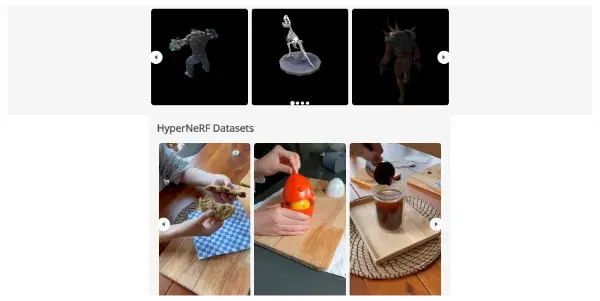4D Gaussian Splatting

Create realistic 3D renderings in real time from a sequence. This model captures even complex movements and can run on a single GPU
4D Gaussian Splatting: Real-time 3D Rendering from Video Sequences
4D Gaussian Splatting is a novel AI-powered tool that revolutionizes real-time 3D rendering by creating photorealistic 3D models directly from video sequences. This innovative approach allows for the capture of intricate details and complex movements, all while being remarkably efficient, running smoothly on a single GPU. This article will delve into its capabilities, applications, and compare it to existing technologies.
What 4D Gaussian Splatting Does
4D Gaussian Splatting takes a sequence of 2D images (a video) as input and outputs a high-fidelity 3D model. Unlike traditional methods that require extensive manual modeling or rely on computationally expensive processes, this tool leverages a unique algorithm to represent the scene as a collection of "splat," each being a small, Gaussian-weighted point cloud. These splats are strategically positioned and weighted to reconstruct the scene's geometry and appearance accurately. The 4D aspect refers to the inclusion of time as a dimension, allowing the model to capture dynamic movement and changes over the sequence. This results in a 3D model that can be rendered in real-time, offering unprecedented interactivity and speed.
Main Features and Benefits
- Real-time Rendering: The processed model can be rendered in real time on a single GPU, making it ideal for interactive applications.
- High-fidelity Reconstruction: The algorithm excels at capturing fine details and complex geometry, producing visually stunning and accurate 3D models.
- Efficient Processing: The model's efficiency stems from the use of Gaussian splats, leading to lower computational demands compared to traditional methods.
- Dynamic Movement Capture: The 4D nature of the process accurately captures motion and temporal changes present in the input video.
- Single GPU Requirement: Eliminates the need for expensive multi-GPU setups, making the technology more accessible.
Use Cases and Applications
The versatility of 4D Gaussian Splatting opens doors for a wide range of applications across various industries:
- Virtual and Augmented Reality (VR/AR): Create realistic and interactive VR/AR experiences from real-world video footage.
- Video Game Development: Quickly generate high-quality 3D assets for games, significantly reducing development time and costs.
- Film and Animation: Use it as a tool for creating realistic digital doubles and environments.
- Architectural Visualization: Generate 3D models of buildings and spaces from video footage, allowing for interactive walkthroughs.
- Robotics and Computer Vision: Employ the technology for precise 3D scene reconstruction in robotics applications and computer vision tasks.
- Digital Heritage Preservation: Create detailed 3D models of historical artifacts or locations from video recordings.
Comparison to Similar Tools
While other methods exist for 3D reconstruction from video, 4D Gaussian Splatting distinguishes itself through its combination of real-time rendering capability, high-fidelity results, and efficiency. Traditional methods like photogrammetry often require significant processing power and time, lack real-time interaction, and may struggle with dynamic scenes. Neural radiance fields (NeRFs) produce high-quality results, but typically require longer rendering times and more computational resources. 4D Gaussian Splatting offers a compelling compromise, delivering a balance between quality, speed, and accessibility.
Pricing Information
4D Gaussian Splatting is currently available for free. However, it's important to note that this may change in the future. Keep an eye on the official project page for the most up-to-date pricing information.
Conclusion
4D Gaussian Splatting represents a significant advancement in real-time 3D reconstruction technology. Its ability to produce high-quality 3D models from video sequences efficiently and with minimal computational requirements opens up exciting possibilities across diverse fields. The free availability of the tool further broadens its accessibility and potential for widespread adoption. As the technology matures, we can expect even more innovative applications and improvements to emerge.